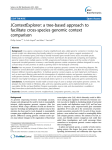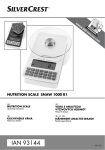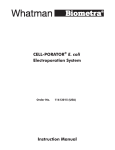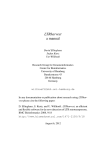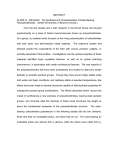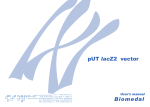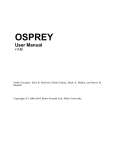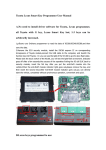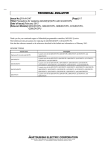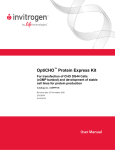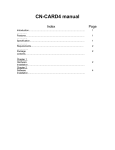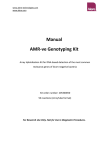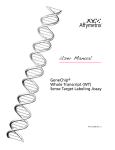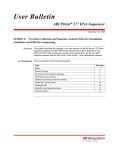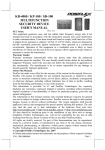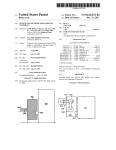Download Primer Island_Book
Transcript
Primer Island_Book Page i Thursday, May 22, 1997 2:47 PM Primer Island Transposition Kit Protocol Primer Island_Book Page ii Thursday, May 22, 1997 2:47 PM Products and procedures described in this protocol are intended for research purposes only. © Copyright 1997, The Perkin-Elmer Corporation All rights reserved. Printed in the U.S.A. The PCR process is covered by patents owned by Roche Molecular Systems Inc., and F. Hoffman-LaRoche, Ltd. Use of the PCR process requires a licence. Information on licenses to practice the PCR process may be obtained by contacting the Director of Licensing at PE Applied Biosystems, 850 Lincoln Center Drive, Foster City, California 94404, or at Roche Molecular Systems, 1145 Atlantic Ave, Alameda, California 94501. This product is sold under licensing arrangements with the Johns Hopkins University for patents pending in “In vitro Transposition of Artificial Transposons.” Perkin-Elmer is a registered trademark of The Perkin-Elmer Corporation. ABI, ABI PRISM, and the ABI PRISM design, Applied Biosystems, AutoAssembler, Factura, PE, and PE Applied Biosystems are trademarks of The Perkin-Elmer Corporation. AmpliTaq is a registered trademark of Roche Molecular Systems, Inc. All other trademarks are the sole property of their respective owners. P/N 402920 Rev. A Primer Island_Book Page i Thursday, May 22, 1997 2:47 PM Contents Introduction . . . . . . . . . . . . . . . . . . . . . . . . . . . . . . . . . . . . . . . . . . . . . . . . . . . .1 Transposons . . . . . . . . . . . . . . . . . . . . . . . . . . . . . . . . . . . . . . . . . . . . . .1 How it Works . . . . . . . . . . . . . . . . . . . . . . . . . . . . . . . . . . . . . . . . . . . . .2 Benefits of This System . . . . . . . . . . . . . . . . . . . . . . . . . . . . . . . . . . . . .2 Artificial Transposon. . . . . . . . . . . . . . . . . . . . . . . . . . . . . . . . . . . . . . . .3 Transposase Mechanism . . . . . . . . . . . . . . . . . . . . . . . . . . . . . . . . . . . . .5 Primers and Priming Sites. . . . . . . . . . . . . . . . . . . . . . . . . . . . . . . . . . . .6 PI(+) and PI(–) Primers and Priming Sites . . . . . . . . . . . . . . . . .6 SD110 and SD111 Nested Priming Sites . . . . . . . . . . . . . . . . . . .6 Control Target DNA . . . . . . . . . . . . . . . . . . . . . . . . . . . . . . . . . . . . . . . .7 Sequencing Control. . . . . . . . . . . . . . . . . . . . . . . . . . . . . . . . . . . . . . . . .7 Materials and Equipment. . . . . . . . . . . . . . . . . . . . . . . . . . . . . . . . . . . . . . . . . .8 Kit Contents . . . . . . . . . . . . . . . . . . . . . . . . . . . . . . . . . . . . . . . . . . . . . .8 Materials Recommended But Not Supplied . . . . . . . . . . . . . . . . . . . . . .9 Storage and Stability . . . . . . . . . . . . . . . . . . . . . . . . . . . . . . . . . . . . . . .11 Technical Support . . . . . . . . . . . . . . . . . . . . . . . . . . . . . . . . . . . . . . . . .11 Safety . . . . . . . . . . . . . . . . . . . . . . . . . . . . . . . . . . . . . . . . . . . . . . . . . .11 5X Transposase Buffer . . . . . . . . . . . . . . . . . . . . . . . . . . . . . . . .11 Other Chemicals. . . . . . . . . . . . . . . . . . . . . . . . . . . . . . . . . . . . .11 Microorganisms . . . . . . . . . . . . . . . . . . . . . . . . . . . . . . . . . . . . .11 Transposition, Electroporation, and Selective Plating . . . . . . . . . . . . . . . . . . .12 Transposition Reaction . . . . . . . . . . . . . . . . . . . . . . . . . . . . . . . . . . . . .12 Transposition Reaction Cleanup . . . . . . . . . . . . . . . . . . . . . . . . . . . . . .14 Preparing for Electroporation . . . . . . . . . . . . . . . . . . . . . . . . . . . . . . . .15 Electroporation . . . . . . . . . . . . . . . . . . . . . . . . . . . . . . . . . . . . . . . . . . .16 Selective Plating . . . . . . . . . . . . . . . . . . . . . . . . . . . . . . . . . . . . . . . . . .18 Data Analysis . . . . . . . . . . . . . . . . . . . . . . . . . . . . . . . . . . . . . . . . . . . . . . . . . .20 i Primer Island_Book Page ii Thursday, May 22, 1997 2:47 PM Transposition Data Analysis. . . . . . . . . . . . . . . . . . . . . . . . . . . . . . . . . 20 Transformation Efficiency . . . . . . . . . . . . . . . . . . . . . . . . . . . . . . . . . . 21 Frequency of Transposition . . . . . . . . . . . . . . . . . . . . . . . . . . . . . . . . . 21 Five-Base Pair Repeats. . . . . . . . . . . . . . . . . . . . . . . . . . . . . . . . . . . . . 22 Target DNA Deletions . . . . . . . . . . . . . . . . . . . . . . . . . . . . . . . . . . . . . 22 Performance Specifications . . . . . . . . . . . . . . . . . . . . . . . . . . . . . . . . . 23 Troubleshooting . . . . . . . . . . . . . . . . . . . . . . . . . . . . . . . . . . . . . . . . . . . . . . . 24 Appendix A. Primer Island Kits and Related Sequencing Kits . . . . . . . . . . 25 Appendix B. Preparing Stop Buffer . . . . . . . . . . . . . . . . . . . . . . . . . . . . . . . 26 Procedure . . . . . . . . . . . . . . . . . . . . . . . . . . . . . . . . . . . . . . . . . . . . . . . 26 Appendix C. References . . . . . . . . . . . . . . . . . . . . . . . . . . . . . . . . . . . . . . . . 27 ii Primer Island_Book Page 1 Thursday, May 22, 1997 2:47 PM Introduction Transposons Transposons (TNs) are mobile genetic elements, regions of nucleic acid capable of inserting themselves or copies of themselves throughout the genome. Naturally occurring transposons encode the proteins that facilitate their movement into and out of DNA. The Primer Island Transposition Kit is based upon the yeast Ty1 transposable element.Ty1 is a retrotransposon of the yeast Saccharomyces cerevisiae. In structure and mechanism it resembles retroviral proviruses. The Ty1 system is the only transposon for which random, high efficiency, in vitro integration has been described (Devine and Boeke, 1994). This in vitro transposition reaction is the basis of the Primer Island Transposition Kit. The in vitro transposition system used in the Primer Island Transposition Kit places unique primer binding sites, “primer islands,” randomly throughout a population of large DNA molecules. These primer sites may be used subsequently for polymerase chain reaction (PCR) amplification or DNA sequencing reactions. Transposon insertion is an alternative to subcloning or primer walking when sequencing a large region of DNA (Devine and Boeke, 1994; Baker-Brachmann et al., 1995; Devine et al., 1997; Nam et al., 1997; Williams et al., 1997). continued on next page 1 Primer Island_Book Page 2 Thursday, May 22, 1997 2:47 PM How it Works The Primer Island Transposition Kit provides the necessary reagents and control system for generating artificial transposon insertions into DNA in vitro. The Primer Island Kit reagents are combined and incubated with a target DNA, which is subsequently purified and electroporated into Escherichia coli. The reagents in this kit have been optimized for transposon insertion into plasmid DNA. Insertion frequencies will vary according to the type and size of the DNA target. To select for bacteria harboring a plasmid with a transposon insertion, the electroporation reaction is plated on Luria-Bertani (LB) agar plates containing the appropriate antibiotics (i.e., one for the target plasmid and a second for the transposon). The artificial transposon, AT-2, is included with the kit. In addition to the unique primer binding sites, AT-2 contains a gene that encodes dihydrofolate reductase (DHFR). DHFR confers resistance to trimethoprim (Fling and Richards, 1983). Assuming that the target plasmid encodes for the gene conferring ampicillin resistance, plating on ampicillin and trimethoprim LB-agar plates should permit the growth of only those bacteria containing a plasmid with a transposon insertion. Each ampicillin-resistant and trimethoprim-resistant colony will typically contain a plasmid with one copy of integrated transposon. Insertions may be mapped by colony PCR amplification, or miniprep DNA may be isolated for DNA sequencing or PCR analysis. For a more detailed explanation of how this technology works, refer to Devine and Boeke (1994), Devine et al. (1997), and Kimmel et al. (1997). Benefits of This The Primer Island Transposition Kit has several advantages: System ♦ Employs a simple in vitro reaction ♦ Uses any plasmid or E. coli host strain ♦ Inserts transposon randomly into diverse DNA sequences ♦ Inserts priming sites for PCR amplification ♦ Inserts priming sites for bidirectional DNA template sequencing continued on next page 2 Primer Island_Book Page 3 Thursday, May 22, 1997 2:47 PM Artificial The linear transposon, AT-2, is shown in Figure 1 on page 4. This Transposon artificial transposon has the following features: Feature How displayed in Figure 1 on page 4 Function Four-base pair termini Labeled “U3” Sequence recognized by Ty1 transposase. Allows the TN to be inserted efficiently into the target DNA. DHFR genea Start and stop codons, GTG and TAA, respectively, are boxed Codes for trimethoprim resistance. Primer binding sites, PI(+) and PI(–) Sequences are shaded: PI(+) extends from nucleotide 809–828. PI(–) extends from nucleotide 42–59. During a sequencing reaction the primers are extended out into the adjacent DNA template, allowing the target DNA to be sequenced bidirectionally. Primer binding sites, SD110 and SD111 Sequences are underlined Allows amplification of PCR products using a single TN-specific primer in conjunction with a vectorspecific primer. Polylinker sequence Boxed Useful for restriction mapping of the site of transposon insertion prior to sequencing. a. The gene was originally derived from Tn7 (Fling and Richards, 1983). 3 Primer Island_Book Page 4 Thursday, May 22, 1997 2:47 PM Pac I BamH I Spe I Xba I Eag I Not I Sac II U3 DHFR SD110 PI(–) Sac II U3 1 45 92 139 186 233 280 327 374 421 468 515 562 609 656 703 750 797 844 GTG Xho I Ava I Sal I Acc I Hind III EcoR V TAA EcoR I SD111 PI(+) Eag I Not I Xba I U3 Spe I BamH I 5' –TGTTCACCGCGGTGGCGGCCGCTCTAGAACTAGTGGATCCTGCA AGCAGGATAGACGGCATGCACGATTTGTAATAACAGAGTGTCTTGTA TTTTTAAAGAAAGTCTATTTAATACAAGTGATTATATTAATTAACGG TAAGCATCAGCGGGTGACAAAACGAGCATGCTTACTAATAAAATGTT AACCTCTGAGGAAGAATTGTGAAACTATCACTAATGGTAGCTATATC GAAGAATGGAGTTATCGGGAATGGCCCTGATATTCCATGGAGTGCCA AAGGTGAACAGCTCCTGTTTAAAGCTATTACCTATAACCAATGGCTG TTGGTTGGACGCAAGACTTTTGAATCAATGGGAGCATTACCCAACCG AAAGTATGCGGTCGTAACACGTTCAAGTTTTACATCTGACAATGAGA ACGTATTGATCTTTCCATCAATTAAAGATGCTTTAACCAACCTAAAG AAAATAACGGATCATGTCATTGTTTCAGGTGGTGGGGAGATATACAA AAGCCTGATCGATCAAGTAGATACACTACATATATCTACAATAGACA TCGAGCCGGAAGGTGATGTTTACTTTCCTGAAATCCCCAGCAATTTT AGGCCAGTTTTTACCCAAGACTTCGCCTCTAACATAAATTATAGTTA CCAAATCTGGCAAAAGGGTTAACAAGTGGCAGCAACGGATTCGCAAA CCTGTCACGCCTTTTGTGCCAAAAGCCGCGCCAGGTTTGCGATCCGC TGTGCCAGGCGTTAGGCGTCATATGAAGATTTCGGTGATCCCTGAGC AGGTGGCGGAAACATTGGATGCTGAGAATTCGATATCAAGCTTATCG ATACCGTCGACCTCGAGAACA– 3' EcoR I Hind III Sal I Acc I Xho I Ava I U3 EcoR V Figure 1 The artificial transposon AT-2. For description refer to “Artificial Transposon” on page 3. Figure adapted from Kimmel et al. (1997). continued on next page 4 Primer Island_Book Page 5 Thursday, May 22, 1997 2:47 PM Transposase The in vitro transposase reaction is catalyzed by a Ty1-encoded Mechanism enzyme complex purified from Saccharomyces cerevisiae strain JB1143. This strain was modified from JB1141 (Devine and Boeke, 1994). The transposase (often referred to as an integrase in the literature) proceeds via a “cut-and-paste” transesterification mechanism to insert the transposon into the target DNA (Craigie, 1992). This process is shown in Figure 2. The DNA sequence shown in Figure 2 has been arbitrarily chosen. During integration, the double-stranded target DNA is cleaved, resulting in a five-base pair staggered cut. The two blunt ends of the linear transposon DNA are simultaneously joined to the target DNA ends by single phosphodiester bonds. Because the reaction requires no additional energy source (i.e., ATP), it is assumed that the energy produced by the strand cleavage is subsequently used to create the phosphodiester bond (Braiterman and Boeke,1994). T A G C C target DNA A T C G G AT-2 Transposon A T C G G AT-2 T A G C C target DNA T A G C C A T C G G AT-2 T A G C C target DNA A T C G G GR0893 E. coli DNA Repair Figure 2 Transposase mechanism The resulting intermediate DNA structure contains 5-bp single-stranded gaps that flank each end of the transposon. The gaps are filled in by an E.coli repair mechanism after transformation and are duplicated during the repair process. The short duplications generated are called “targetsite duplications”. The Primer Island Transposition Kit has been optimized to produce single transposon insertions in a plasmid target. The distribution of 5 Primer Island_Book Page 6 Thursday, May 22, 1997 2:47 PM transposition events will be randomly distributed over the target. The sequence of the DNA insertions can be manipulated using Factura™ and AutoAssembler ™ software. The software removes vector, TN, and target-site duplication sequences and aligns overlapping DNA sequences. Primers and PI(+) and PI(–) Primers and Priming Sites Priming Sites The primers, PI(+) and PI(–), bind to the priming sites that appear shaded on the AT-2 transposon figure (Figure 1 on page 4). The sequences of the primers are: PI(+): 5´-CAGGACATTGGATGCTGAGAATTCG-3´ PI(–): 5´-CAGGAGCCGTCTATCCTGCTTGC-3 Fluorogenic versions of these primers are available from PE Applied Biosystems as components of Primer Island Sequencing Kits. These kits are used in conjunction with the ABI PRISM™ Dye Primer Cycle Sequencing Core Kit. Refer to Appendix A on page 25 for part numbers. These primers are similar to the SD118 and SD119 primers described by Boeke and Devine (1994). However, they have been modified by the addition of a mobility tag (CAGGA) to the 5´end of each oligonucleotide. In addition, primer-specific mobility files have been designed for these primers and are available on the Internet at the PE Applied Biosystems FTP site: ftp://192.43.251.1/pub/public SD110 and SD111 Nested Priming Sites An additional set of primer binding sites, called SD110 and SD111, is located internal to the PI(+) and PI(–) sites. One of these sites can be used in conjunction with a vector-specific priming site to amplify PCR products. Sizing of these PCR products can be used to map the location of the TN insert in the vector. These PCR products can subsequently be sequenced using the PI(+) and PI(–) sequencing primers. continued on next page 6 Primer Island_Book Page 7 Thursday, May 22, 1997 2:47 PM Control Target A plasmid control is included with the Primer Island Transposition Kit. DNA This control is used to establish the frequency of transposon insertion, a measure of reagent performance. This plasmid consists of an insert of 527 base pairs from lambda DNA and confers ampicillin resistance. For the sequence of the plasmid, refer to the PE Applied Biosystems FTP site on the Internet. The address is referenced in “Primers and Priming Sites” on page 6. Sequencing A Sequencing Control has been included in the kit. This plasmid has Control binding sites for the PI(+) and PI(–) primers. For the sequence of the plasmid, refer to the PE Applied Biosystems FTP site. The address is referenced in “Primers and Priming Sites” on page 6. 7 Primer Island_Book Page 8 Thursday, May 22, 1997 2:47 PM Materials and Equipment Kit Contents The Primer Island Transposition Kit contains sufficient reagents for 20 transposition reactions: Table 1. Kit Reagents Reagent Volume Description Transposase 40 µL One vial containing the transposase enzyme complex in 10 mM HEPESKOH, pH 7.8, 15 mM KCl, 5 mM EDTA, 50% sucrose 5X Transposase Buffer 200 µL One vial containing 50 mM Tris, pH 7.5, 50 mM MgCl2, 5 mM DTT, 25% PEG 8000 AT-2 Transposon 20 µL One vial containing 200 µg/mL of purified transposon stored in 10 mM Tris, 1 mM EDTA, pH 8.0 Control Target DNA 25 µL One vial containing 1 mg/mL of control plasmid stored in 10 mM Tris, 1 mM EDTA, pH 8.0 DNA Sequencing Control 34 µL One vial containing 200 µg/mL purified, double-stranded, sequencing template. The template is stored in 10 mM Tris, 1 mM EDTA, pH 8.0 Note Refer to Appendix A on page 25 for descriptions and part numbers of kits closely related to the Primer Island Transposition Kit. continued on next page 8 Primer Island_Book Page 9 Thursday, May 22, 1997 2:47 PM Materials The items listed in Table 2 and Table 3 are recommended in addition to Recommended the reagents supplied with the Primer Island Transposition Kit. But Not Supplied Table 2. User-supplied equipment Equipment Items Source ABI™ See your local PE Applied Biosystems representative for more information concerning these products. 373 DNA Sequencer, ABI PRISM 377 DNA Sequencer, or ABI PRISM 310 Genetic Analyzer Factura software AutoAssembler software 1.5-mL microcentrifuge tubes Major laboratory suppliers (MLS) 15-mL polypropylene screw-cap tubes MLS Adjustable volume pipettors, 0–20 µL, 20–200 µL, 100–1000 µL MLS Bunsen burner MLS Cell-Porator E. coli Electroporation System Life Technologies, Inc. (P/N 11613-015) Disposable gloves MLS Environmental shaker, 37 °C MLS Fine-bore gel loading pipette tips, filter plugged, 200 µL capacity MLS Incubator, 37 °C MLS Microcentrifuge MLS Microelecroporation chamber Life Technologies, Inc. (P/N 11608-015) Plate streaker MLS Pipette tips, with filter plugs MLS Rotating platform for uniform streaking of agar plates MLS Two heat blocks, 30 °C and 65 °C MLS Thermometers, 0–100 °C MLS Vacuum centrifuge DuPont Speedvac or MLS 9 Primer Island_Book Page 10 Thursday, May 22, 1997 2:47 PM Table 3. User-supplied reagents Reagent Items Source Ammonium acetate, molecular biology grade Major laboratory suppliers (MLS) Carbenicillin-LB agar platea Teknova, Inc.b (P/N 0133-C75) or MLS Deionized water, nuclease and protease-free MLS EDTA, molecular biology grade MLS Electromax-competent, frozen E. coli cells, strain DH10B Life Technologies, Inc. (P/N 18290-015) Ethanol MLS Isopropanol Fluka (P/N 59304) Proteinase K PE Applied Biosystems (P/N 400457) S.O.C. Medium Life Technologies, Inc. (P/N 15544-018) SDS, molecular biology grade MLS Trimethoprim/Carbenicillin-LB agar platesa Teknova, Inc. (P/N 0133-C75M75) or MLS a. We prefer carbenicillin to ampicillin because of its stability properties. The ampR gene confers resistance to both antibiotics. If ampicillin is used, prepare fresh plates with 50 µg/mL ampicillin. b. Teknova, Inc. (Half Moon Bay CA, 415-728-2557) continued on next page 10 Primer Island_Book Page 11 Thursday, May 22, 1997 2:47 PM Storage and Upon receipt, store the Primer Island Transposition Kit at –15 to –25 °C Stability in a constant-temperature freezer. If stored under the recommended conditions, the product will maintain performance through the control date printed on the label. Technical Support In the United States or Canada, call (800) 831-6844 for technical support. Outside the United States and Canada, call you local sales office. Sales office numbers are given on the back cover of this protocol. Safety Please adhere to the following safety warnings. 5X Transposase Buffer ! WARNING ! CHEMICAL HAZARD. May cause skin, eye, and respiratory tract irritation. Wear gloves, a lab coat, and protective eyewear when handling. If contacted, wash affected area with large amounts of water for 15 minutes. Other Chemicals ! WARNING ! CHEMICAL HAZARD. Certain chemicals used with this kit may be hazardous and require special handling. Do not store, handle, or work with any chemicals or hazardous materials unless you have received appropriate safety training and have read and understood all related Material Safety Data Sheets. Comply with all federal, state, and local laws related to chemical storage, handling and disposal. Microorganisms ! WARNING ! Always follow CDC-NIH principles of biosafety for activities involving biological agents. These principles can be found in the U.S. Department of Health and Human Services Publication No. (CDC) 93-8395, Biosafety in Microbiological and Biomedical Laboratories. 11 Primer Island_Book Page 12 Thursday, May 22, 1997 2:47 PM Transposition, Electroporation, and Selective Plating Transposition During the transposition reaction, transposons are randomly integrated Reaction into the target DNA. The insertion is facilitated by a protein complex containing transposase. This reaction is described in detail by Devine and Boeke (1994) and by Kimmel et al. (1997). IMPORTANT Target DNA purity is critical. Plasmid DNA should be purified by a standard method such as CsCl-gradient centrifugation (Sambrook et al., 1989) or by column purification kits such as those sold by Qiagen or PE Applied Biosystems (P/N 401015). Miniprep DNA does not perform well in this reaction. To complete the transposition reaction: Step Action 1 Thaw frozen reagents. When thawed, mix thoroughly by flicking the tube and inverting it several times. 2 Set up the following reaction in a 1.5-mL microcentrifuge tube. Reagents are listed in preferred order of addition: Reagent Deionized water Volume (µL) 12 5X Transposase Buffer 4 AT-2 Transposon, 0.2 µg 1 Control Target DNA, 1 µg or desired target DNA at 1 µg/µL 1 Transposase 2 Total volume 20 Note The target DNA preparation can be resuspended in 1X TE or sterile, deionized water. Adjust the volume of deionized water in the reaction according to the volume of target DNA used. The total volume of deionized water and target DNA in the reaction is 13 µL. 3 Mix reagents gently. Do not vortex. 4 Incubate at 30 °C for one hour. 5 Prepare Stop Buffer immediately prior to use. Refer to Appendix B on page 26. Note Using anything other than freshly-prepared Stop Buffer may result in low electroporation efficiencies. 12 Primer Island_Book Page 13 Thursday, May 22, 1997 2:47 PM To complete the transposition reaction: (continued) Step Action 6 Stop the reaction by adding 5 µL of freshly-made Stop Buffer and incubating at 65 °C for 30 minutes. 7 Proceed to “Transposition Reaction Cleanup” on page 14. continued on next page 13 Primer Island_Book Page 14 Thursday, May 22, 1997 2:47 PM Transposition Follow the steps below to precipitate, wash and resuspend the DNA. Reaction Cleanup To clean up the transposition reaction: Step 1 Action After 30 minutes at 65 °C, briefly centrifuge the samples to collect condensate at the tube bottom. Add the following: ♦ 25 µL deionized water ♦ 25 µL 7.5 M ammonium acetate ♦ 75 µL isopropanol Note Ethanol precipitation can be performed instead of isopropanol precipitation. Refer to Sambrook et al. (1989) for DNA precipitation methods. 2 Centrifuge immediately in a microfuge at 14,000 rpm for 30 minutes at 2–6 °C. Note Quantitative DNA recovery is essential for an adequate yield of trimethoprim-resistant (tmpR) colonies. An excellent way to achieve this is to pellet the DNA to the bottom of the tube by using a rotor which secures the sample at a right angle with respect to the spindle axis. Alternatively, if a fixed angle rotor is used, be sure to resuspend the DNA by washing the side wall of the microcentrifuge tube extensively in step 6. 3 Carefully remove the supernatant with a 200 µL fine-bore pipet tip. Leave 5–10 µL of supernatant at the bottom of the tube. Note Do not allow the pipet tip to disturb the DNA pellet. 4 Rinse the pellet with 500 µL of ice-cold 70% ethanol and repeat step 2 and step 3. 5 Place the tube on the bench to air dry, or dry in a vacuum centrifuge for several minutes. 6 Resuspend the DNA pellet in 20 µL of sterile, deionized water. The final DNA concentration should be approximately 50 ng/µL. IMPORTANT Do not resuspend the DNA in 1X TE (10 mM Tris, 1 mM EDTA) or any conductive buffer. 7 Proceed to “Preparing for Electroporation” on page 15. continued on next page 14 Primer Island_Book Page 15 Thursday, May 22, 1997 2:47 PM Preparing for After completing the transposition reaction and post-reaction DNA Electroporation clean-up, prepare for the electroporation of the transposition reaction into electrocompetent DH10B E. coli cells. The procedures described below and in “Electroporation” on page 16 apply to use of an electroporator from Life Technologies, Inc. Similar devices from other manufacturers may also be used. IMPORTANT All electroporation components must be chilled to 2–6 °C prior to contact with E. coli cells. To prepare for electroporation: Step 1 Action Store the two-section base and the disposable microelectroporation chambers at 2–6 °C. Place on ice immediately before use. ~~ Lid Disposable Microelectroporation Chamber Positioning post Top-base Chamber Bottom-base Chamber Copyright 1997, Life Technologies, Inc. All rights reserved. 2 Prechill one microcentrifuge tube for each sample. 3 Separate the base into two components. Fill the top-base chamber with water and ice, then attach the bottom-base chamber. Place at 2–6 °C until ready to use. Allow the base to chill for at least 30 minutes before electroporation. 15 Primer Island_Book Page 16 Thursday, May 22, 1997 2:47 PM To prepare for electroporation: (continued) Step 4 Action Turn on the electroporator to allow time for warm up. Allow a 30-minute warmup before charging the capacitor. Set the voltage range to Medium. CELL–PORATOR® E. coli Pulser READY CHARGE VOLTAGE (kV) TRIGGER MEDIUM LOW HIGH VOLTAGE RANGE POWER Copyright 1997, Life Technologies, Inc. All rights reserved. 5 Place 1 mL of S.O.C. Medium into a 15-mL polypropylene tube. Leave on the bench top at room temperature. Prepare one tube for each sample. 6 Thaw the electrocompetent DH10BE. coli cells on ice, 15–25 minutes before use. Note Competent DH10B E. coli cells should be stored at –70 °C. A decline in electroporation efficiency is observed if cells remain thawed for an extended time period. 7 Proceed to “Electroporation.” Electroporation The procedure below describes the steps for electroporation. IMPORTANT Poor transposition frequencies may result from low electroporation efficiencies. To perform electroporation: Step 1 16 Action For each sample place 1 µL of chilled DNA and 16 µL of competent DH10B E. coli cells into a prechilled-microcentrifuge tube. Store the remainder of the transposition reaction at –15 to –25 °C. Primer Island_Book Page 17 Thursday, May 22, 1997 2:47 PM To perform electroporation: (continued) Step 2 Action To monitor the efficiency of the electroporation, use the pUC 19 control plasmid provided with the electrocompetent DH10B E. coli cells. Dilute the pUC 19 control with sterile, deionized water to a concentration of 2.5 ng/µL. Place 1 µL of plasmid DNA and 16 µL of electrocompetent DH10B E. coli cells into a prechilledmicrocentrifuge tube. 3 Check that the electroporator is charged. The voltage display should read approximately 2.45 kV. 4 Pipette 16 µL of the DNA + E.coli mixture into the gap between the two electrodes of the prechilled-microelectroporation chamber. Make sure the droplet does not contain any bubbles. Gently close the top. Note The droplet must remain in the electrode gap. Do not squeeze the body of the microelectroporation chamber, as this may alter the interelectrode distance. Handle the microelectroporation chamber at the rounded head. Copyright 1997, Life Technologies, Inc. All rights reserved. 5 Place the disposable microelectroporation chamber into the chilled base. 17 Primer Island_Book Page 18 Thursday, May 22, 1997 2:47 PM To perform electroporation: (continued) Step Action 6 Place the lid on the base and tighten by clockwise rotation. 7 Press the Trigger (red button) of the electroporator. 8 Immediately pour 1 mL of S.O.C. Medium from the 15-mL polypropylene tube into the microelectroporation chamber, thus washing the droplet of DNA and E. coli from the electrode gap. 9 Pour the contents of the microelectroporation chamber back into the 15-mL polypropylene tube. Leave on the bench top at room temperature. 10 Repeat steps 3–8 until all of the samples and the pUC 19 controls have been electroporated and resuspended in S.O.C. Medium. 11 Shake the tubes at 225 rpm for 60 minutes at 37 °C. 12 Proceed to “Selective Plating.” Selective Plating Follow the procedure below for making serial dilutions of the electroporated DH10B cells and plating them on selective media. Two types of selective media will be used: ♦ Carbenicillin (75 µg/mL) in LB agar ♦ Carbenicillin and Trimethoprim (each at 75 µg/mL) in LB agar Note This protocol provides guidelines for DH10B plating dilutions. The appropriate dilution will depend on your DNA sample. The goal is to select plating dilutions that will yield 100–300 colony-forming units (CFU) per plate. To make dilutions and plate cells: Step 1 Action Prepare plating dilutions by setting up six 1.5-mL microcentrifuge tubes for each electroporated sample, except pUC 19 (see step 6). Label the dilution series as follows: ♦ 18 10–1, 10–2, 10–3, 10–4, 10–5, 10–6 2 Pipette 900 µL of S.O.C. Medium into each tube. 3 Pipette 100 µL of electroporated E. coli bacteria into the tube labeled “10–1.” Gently invert the closed tube several times. Remove 100 µL from this tube and pipette the volume into the tube labeled “10–2.” 4 Repeat mixing-and-pipetting routine until all tubes for a dilution series contain electroporated bacteria. Primer Island_Book Page 19 Thursday, May 22, 1997 2:47 PM To make dilutions and plate cells: (continued) Step Action 5 Repeat this serial dilution procedure until each of the electroporated samples is serially diluted. 6 Prepare plating dilutions for the pUC 19 electroporation control by setting up five 1.5-mL microcentrifuge tubes. Label this dilution series as follows: ♦ 10–1, 10–2, 10–3, 10–4, 10–5 7 Repeat steps 2–4 for the pUC 19 controls. 8 For each of the following dilutions, plate 100 µL of the transposition/DH10B electroporation mixture onto carbenicillin LB-agar plates: ♦ 10–5 ♦ 10–6 Note The agar plates should not be wet or have condensation on the lids. Prewarm the plates at 37 °C for 30 minutes prior to use. Plate in triplicate to ensure accuracy when assessing transposition frequency and electroporation efficiency. 9 10 For each of the following dilutions, plate 100 µL of the transposition/DH10B electroporation mixture onto carbenicillin/trimethoprim LB-agar plates: ♦ Undiluted ♦ 10–1 For each of the following dilutions, plate 100 µL of pUC 19/DH10B electroporation mixture onto carbenicillin LB-agar plates: ♦ 10–4 ♦ 10–5 11 Plate 100 µL of undiluted pUC 19/DH10B electroporation mixture onto carbenicillin/trimethoprim LB-agar plates. 12 Invert the plates and place them at 37 °C overnight. Note 13 Discard all serial dilutions upon completion of step 10. Proceed to “Data Analysis” on page 20. 19 Primer Island_Book Page 20 Thursday, May 22, 1997 2:47 PM Data Analysis Transposition Data Count bacterial colonies and determine the efficiencies and frequencies Analysis of transposition. Step 1 Action The following morning, count the number of colony-forming units (CFU) per LB-agar plate. Note Colonies plated on carbenicillin LB-agar plates grow faster than colonies plated on carbenicillin/trimethoprim LB-agar plates. Incubating plates for excessive time intervals will cause colonies to fuse, making them difficult to tabulate accurately. Colonies displaying a broad range of diameters may grow on carbenicillin/trimethoprim LB-agar plates. For an accurate CFU determination, count all colonies regardless of diameter. 2 Calculate the following as described on page 21: ♦ efficiency of transformation to carbenicillin resistance ♦ efficiency of transformation to carbenicillin/trimethoprim resistance ♦ frequency of transposition 3 Pick several colonies from the carbenicillin/trimethoprim plates and isolate the plasmid DNA using a standard small-scale isolation (miniprep) procedure. 4 Amplify the purified transformant DNA using PCR for mapping and/or sequencing, or immediately perform Cycle Sequencing as described in the ABI PRISM Dye Primer Cycle Sequencing Core Kit Protocol (P/N 402114). continued on next page 20 Primer Island_Book Page 21 Thursday, May 22, 1997 2:47 PM Transformation Transformation efficiency (TF), or electroporation efficiency, is defined Efficiency as the number of CFU of transformed bacteria produced per microgram of DNA subjected to electroporation. Calculate the transformation efficiency for each electroporation using the formula: TF = 1 CFU × 103 ng × Dilution × = CFU Factor µg ng DNA µg DNA Fraction of Dilution Plated For example, DH10B is electroporated with 2.5 ng of pUC 19, and 1 mL of a 10–5 dilution of electroporated bacteria is prepared. A 100 µL plating of the 10–5 dilution yields 25 CFU. The transformation efficiency is calculated as follows: 103 ng 1 = 1×1010 CFU TF = 25 CFU × × 105 × µg µg DNA 2.5 ng (100 µL/1 mL) Frequency of The Frequency of Transposition, F(Tp), is defined as the frequency of Transposition transposon insertion into the Control Target DNA and is expressed as the ratio of two transformation efficiencies: ♦ the efficiency of transforming DH10B to carbenicillin/trimethoprim resistance (with the target DNA containing at least one copy of the transposon) ♦ the efficiency of transforming DH10B to carbenicillin resistance This ratio is expressed mathematically as follows: F(Tp) = TF (carbR, tmpR) Efficiency of carbR, tmpR transformation = TF (carbR) Efficiency of carbR transformation continued on next page 21 Primer Island_Book Page 22 Wednesday, May 7, 1997 5:16 PM Five-Base Pair As discussed in “Transposase Mechanism” on page 5, the insertion of Repeats the AT-2 transposon into the target DNA results in the generation of a five-base pair target-site duplication. This sequence flanks the transposon. If the DNA is being sequenced by the ABI 373 or ABI PRISM 377 DNA Sequencer, then the raw data can be imported into Factura software to remove vector sequences from sequencing files. Factura software can also be used to recognize and remove the TN sequence from the sequencing file. AutoAssembler software from PE Applied Biosystems can be used to align overlapping DNA sequences and remove 5-bp target-site duplications from the template sequence. These duplications provide a useful point to generate a “mini-contig” from each transposition. Target DNA A deletion of a segment of the target DNA occurs infrequently during Deletions transposon insertion. The reasons for deletion of target DNA are not known, but appear to be target DNA sequence dependent. There are two indications of a target DNA deletion: ♦ The typical 5-bp target-site duplication is not observed. (Refer to Figure 2 on page 5 for transposase mechanism). ♦ The sequences from both ends of the transposon do not align as expected during the final sequence assembly. The sequences may be separated by ten base pairs to several kilobases, depending upon the size of the target DNA deletion. When a target DNA deletion occurs, the sequence data obtained from each end of the transposon is valid. There have been no reports of internal deletions or scrambling of sequences by the transposon. The two sequences may be considered separately and assembled accordingly. continued on next page 22 Primer Island_Book Page 23 Thursday, May 22, 1997 2:47 PM Performance The performance specification is based upon the frequency of Specifications transposition, F(Tp). Using control reagents and protocol, the F(Tp) value should equal or exceed 1 × 10–5. That is, for every 109 carbenicillin-resistant transformants recovered, at least 104 transposition events should be recovered. Note Inefficient electroporation will adversely impact the yield of trimethoprim-resistant colonies. Twenty nanograms of Control Target DNA recovered from the transposition reaction should yield 100–300 carbenicillin-resistant, trimethoprim-resistant bacterial colonies. 23 Primer Island_Book Page 24 Thursday, May 22, 1997 2:47 PM Troubleshooting . Observation tmpR bacterial Poor recovery of colonies and the transformation efficiency of the pUC 19 control is >1 × 1010 CFU/µg Possible Cause Recommended Action DNA impurities Establish the transposition frequency empirically, using your reagents with the Control Target DNA. Compare with the transposition frequency obtained using your template DNA. or The transformation efficiency of bacteria plated on carbenicillin (carbR) is at least a factor of 106 greater than the transformation efficiency of bacteria plated on carbenicillin/trimethoprim (carbR/tmpR) No tmpR colonies recovered and the transformation efficiency of the pUC 19 control is <8 × 109 CFU/µg Bacterial “background” growth on LB-agar plates is too high 24 Purify plasmid DNA using column chromatography or CsCl centrifugation. Miniprepped DNA is not recommended. Electrophorese cut and uncut target DNA (overloaded) on an agarose gel to screen for contaminants. DNA contaminated with protein Extract the transposition reaction with phenol/chloroform. Precipitate the DNA using isopropanol or ethanol followed by a 70% ethanol wash. Inadequate recovery of DNA pellet Following precipitation of the transposition reaction, carefully resuspend all of the DNA by washing the walls of the tube. Incorrect electroporator settings or poor technique Check electroporator settings. Bad agar plate or aggressive bacterial growth Switch to M9-agar plates to reduce growth rates. Repeat pUC 19 electroporation after reviewing the troubleshooting guide in the electroporator user’s manual. Primer Island_Book Page 25 Thursday, May 22, 1997 2:47 PM Appendix A. Primer Island Kits and Related Sequencing Kits Name P/N Description Primer Island Transposition Kit 403015 Contains reagents necessary to perform 20 transposition reactions. Includes the protocol. Primer Island Transposition Kit 402984 Contains reagents necessary to perform 20 transposition reactions. Does not include the protocol. Primer Island Transposition Kit Protocol 402920 Primer Island(+) Dye Primers 402983 Contains the PI(+) primers only, sufficient for 50 sequencing reactions. Primers are labeled with 5-FAM, JOE, TAMRA, and ROX. Primer Island(–) Dye Primers 402982 Contains the PI(–) primers only, sufficient for 50 sequencing reactions. Primers are labeled with 5-FAM, JOE, TAMRA, and ROX. Primer Island(+) Sequencing Kit 403014 Contains reagents necessary to perform 100 sequencing reactions. Contains the PI(+) primers and P/N 402070. Primers are labeled with 5-FAM, JOE, TAMRA, and ROX. Primer Island(–) Sequencing Kit 403013 Contains reagents necessary to perform 100 sequencing reactions. Contains the PI(–) primers and P/N 402070. Primers are labeled with 5-FAM, JOE, TAMRA, and ROX. Primer Island(+/–) Sequencing Kit 402980 Contains reagents necessary to perform 100 sequencing reactions. Contains the PI(+) and PI(–) primers and P/N 402070. ABI PRISM Dye Primer Cycle Sequencing Core Kit Protocol 402114 ABI PRISM Dye Primer Cycle Sequencing Core Kit with AmpliTaq® DNA polymerase, FS 402125 Contains reagents to perform 100 sequencing reactions. Does not contain primers. Includes the protocol. ABI PRISM Dye Primer Cycle Sequencing Core Kit with AmpliTaq DNA polymerase, FS 402070 Same reagents as P/N 402125 above. Does not include the protocol. 25 Primer Island_Book Page 26 Thursday, May 22, 1997 2:47 PM Appendix B. Preparing Stop Buffer Procedure The table below describes how to prepare the Stop Buffer used in the “Transposition Reaction” on page 12. Step 1 Action Combine the following: Reagent Volume (µL) Deionized water 27.5 0.5 M EDTA 50.0 10% SDS 10.0 40 mg/mL Proteinase K 12.5 Total volume 100.0 Note The Proteinase K should be suspended in 10 mM CaCl2, aliquoted and frozen at –70 °C. Under these storage conditions, the stock is usable for months. Do not reuse thawed aliquots. 26 2 If a precipitate appears in the Stop Buffer, warm the bottom of the microcentrifuge tube by gently rubbing it with your fingers. 3 Gently mix the tube. Do not vortex. Primer Island_Book Page 27 Thursday, May 22, 1997 2:47 PM Appendix C. References Baker-Brachmann, C., Sherman, J.M., Devine, S.E., Cameron, E., Pilus, L., and Boeke, J.D. 1995. The SIR2 gene family, conserved from bacteria to humans, functions in silencing, cell cycle progression, and chromosome stability. Genes Dev. 10: 2888–2902. Braiterman, L.T., and Boeke, J.D. 1994. In vitro integration of Ty1: a direct physical assay. Mol. Cell. Biol. 14: 5719–5730. Craigie, R. 1992. Hotspots and warmspots: integration specificity of retroelements. Trends Genet. 8: 187–189. Devine, S.E., and Boeke, J.D. 1994. Efficient integration of artificial transposons into plasmid targets in vitro: a useful tool for DNA mapping, sequencing and functional analysis. Nucleic Acids Res. 22: 3765–3772. Devine, S.E., Chissoe, S.L., Eby, Y., Wilson, R.K., and Boeke, J.D. 1997. A transposon-based strategy for sequencing repetitive DNA in eukaryotic genomes. Genome Res., in press. Fling, M.E., and Richards, C. 1983. The nucleotide sequence of the trimethoprim-resistant dihydrofolate reductase gene harbored by Tn7. Nucleic Acids Res. 11:5147–5158. Kimmel, B., Palozzolo, M.J., Martin, C.H., Boeke, J.D., and Devine, S.E. 1997. Transposon-mediated DNA sequencing. Birren, B., Green, E., Hieter, P., and Myers, R. eds. In: Genome Analysis, a Laboratory Manual. Cold Spring Harbor Press, New York, NY. In press. Nam, K., Lee, G., Trambley, J., Devine, S.E., and Boeke, J.D. 1997. Severe growth defect in Schizosaccharomyces pombe mutant defective in intron lariat degradation. Mol. Cell. Biol. 17: 809–819. Sambrook, J., Fritsch, E.F., and Maniatis, T. 1989. Molecular Cloning, A Laboratory Manual (Second Edition). Cold Spring Harbor Laboratory Press, Cold Spring Harbor, NY. U.S. Department of Health and Human Services. 1993. Publication No. (CDC) 93-8395. Biosafety in Microbiological and Biomedical Laboratories, 3rd edition, U.S. Government Printing Office. 27 Primer Island_Book Page 28 Thursday, May 22, 1997 2:47 PM Williams, S., Hayes, L., Elsenboss, L., Williams, A., Andre, C., Abramson, R., Thompson, J.F., and Milos, P.M. 1997. Sequencing of the cholesteryl ester transfer protein 5´ regulatory region using artificial transposons. Gene, in press. 28 Primer Island_Book Page iii Thursday, May 22, 1997 2:47 PM Primer Island_Book Page iv Thursday, May 22, 1997 2:47 PM Regional Sales Offices THE AMERICAS United States PE Applied Biosystems 850 Lincoln Centre Drive Foster City, CA 94404 Tel: (415) 570-6667 (800) 345-5224 Fax: (415) 572-2743 Canada Mississauga, Ontario Tel: (905) 821-8183 (800) 668-6913 Fax: (905) 821-8246 Latin America Del.A. Obregon, Mexico Tel: 52-5-651-7077 Fax: 52-5-593-6223 EUROPE Benelux Nieuwerkerk a/d Ijssel, Netherlands Tel: 31 (0)180-331400 Fax: 31 (0)180-331409 Chekia Rep. Praha Tel: 2-61 22 21 64 Fax: 2-61 22 21 68 Denmark Allerød Tel: 48 100 400 Fax: 48 100 401 Finland Espoo Tel: 0 880 144 Fax: 0 803 8002 France Paris Tel: (1) 49.90.18.00 Fax: (1) 48.63.22.82 Germany Weiterstadt Tel: (0) 6150/101-0 Fax: (0) 6150/101-101 P/N 402920 Rev. A Hungary Budapest Tel: 1-251 11 16 Fax: 1-251 14 61 Italy Milano Tel: Fax: (039) 23831 (039) 2383490 Norway Oslo Tel: (0) 22 68 65 65 Fax: (0) 22 68 70 68 Poland Warszawa Tel: 22 33 09 36 Fax: 22 33 09 96 Russia Moskva Tel: 095 952 7961 Fax: 095 952 7514 Spain Madrid Tel: (1) 803-4210 Fax: (1) 804-0414 Sweden Sundbyberg Tel: 08 706 22 00 Fax: 08 706 22 01 Switzerland Rotkreuz Tel: 041-799 7708 Fax: 041-790 0676 United Kingdom Warrington, Cheshire Tel: (01925) 825650 Fax: (01925) 282502 All Other European Countries/Middle East/West Asia, Africa Langen, Germany Tel: 49 6103 708 301 Fax: 49 6103 708 310 JAPAN, PACIFIC RIM Chiba, Japan Tel: (0473) 80-8500 Fax: (0473) 80-8505 EASTERN ASIA, CHINA, OCEANIA Australia Scoresby, Victoria Tel: (03) 9212-8585 Fax: (03) 9212-8502 China Beijing Tel: 86 10 6238 1156 Fax: 86 10 6238 1162 Hong Kong Tel: 852 2590 0238 Fax: 852 2590 0513 Korea Seoul Tel: Fax: 822 592 7238 822 532 4908 Malaysia Kuala Lumpur Tel: 60 3 758 1118 Fax: 60 3 758 5688 Singapore Tel: 65 336 0322 Fax: 65 338 3991 Taiwan Taipei Hsisn Tel: 886 2 698 3505 Fax: 886 2 698 3405 Thailand Bangkok Tel: 662 719 6405 Fax: 662 319 9788


































